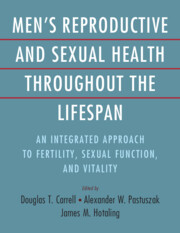 Men's Reproductive and Sexual Health Throughout the Lifespan
Men's Reproductive and Sexual Health Throughout the Lifespan from Section 1 - An Introduction to Men’s Health Care
Published online by Cambridge University Press: 06 December 2023
The internet constantly evolves and facilitates the development of new avenues for users to interact and communicate internationally. Social media and search engines represent the forefront of internet technologies that enable users to produce content, develop digital participatory networks, and share information across various topics. These internet tools are reshaping the continuum of care by enabling patients to acquire medical information, consult peers and healthcare practitioners, and even make treatment decisions without leaving their connected device. The consequences of circumventing traditional pathways to care are amplified in men’s health due to the fact that men frequently do not engage with the healthcare system and that erectile dysfunction and male infertility are stigmatized. The focus of this chapter is to evaluate the emerging online landscape for common men’s health conditions including male infertility, erectile dysfunction, hypogonadism, and Peyronie’s disease.
To save this book to your Kindle, first ensure [email protected] is added to your Approved Personal Document E-mail List under your Personal Document Settings on the Manage Your Content and Devices page of your Amazon account. Then enter the ‘name’ part of your Kindle email address below. Find out more about saving to your Kindle.
Note you can select to save to either the @free.kindle.com or @kindle.com variations. ‘@free.kindle.com’ emails are free but can only be saved to your device when it is connected to wi-fi. ‘@kindle.com’ emails can be delivered even when you are not connected to wi-fi, but note that service fees apply.
Find out more about the Kindle Personal Document Service.
To save content items to your account, please confirm that you agree to abide by our usage policies. If this is the first time you use this feature, you will be asked to authorise Cambridge Core to connect with your account. Find out more about saving content to Dropbox.
To save content items to your account, please confirm that you agree to abide by our usage policies. If this is the first time you use this feature, you will be asked to authorise Cambridge Core to connect with your account. Find out more about saving content to Google Drive.